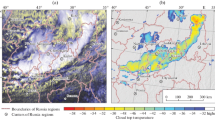Abstract
Synoptic conditions of severe squalls and two tornados in the north of Bashkortostan on June 1, 2007 and August 29, 2014 are anatyzed ustng radar and sateltite data and the forecasts of mesoscale models. The effects of geographic environment and mesoscale features are considered whose consideration enables predicting severe convective events with the lead time of 1-6 hours with the error of about 20 km.
Similar content being viewed by others
References
S. M. Abdullaev, A. A. Zhelnin and O. Yu. Lenskaya, “Life Cycle of Mesoscale Convective Systems,” Meteorol. Gidrol., No. 5 (2009) [Russ. Meteorol. Hydrol., No. 5 (2009)].
A. A. Alekseeva, “Methods of Forecasting of Maximum Amount of Precipitation in the Zones of Active Convection and Alternative Forecast of Heavy Showers and Squalls,” in The Results of Testing New and Improved Models and Methods of Hydrometeorological Forecasting, No. 34 (Nizhnii Novgorod, 2007) [in Russian].
A. A. Vasil’ev, B. E. Peskov, and A. I. Snitkovskii, Tornados on June 9, 1984 (Gidrometeoizdat, Leningrad, 1985) [in Russian].
E. V. Vasil’ev, A. A. Alekseeva, and B. E. Peskov, “Conditions for Formation and Short-range Forecasting of Severe Squalls,” Meteorol. Gidrol., No. 1 (2009) [Russ. Meteorol. Hydrol., No. 1, 34 (2009)].
N. F. Vel’tishchev, V. D. Zhupanov, and Yu. B. Pavlyukov, “Short-range Forecast of Heavy Precipitation and Strong Wind Using the Convection-allowing WRF Models,” Meteorol. Gidrol., No. 1 (2011) [Russ. Meteorol. Hydrol., No. 1, 36 (2011)].
N. F. Vel’tishchev and V. M. Stepanenko, Mesometeorological Processes. Manual (MGU, Moscow, 2007) [in Russian].
R. M. Vil’fand, G. S. Rivin, and I. A. Rozinkina, “COSMO-RU System of Nonhydrostatic Mesoscale Short-range Weather Forecast of the Hydrometcenter of Russia: The First Stage of Realization and Development,” Meteorol. Gidrol., No. 8 (2010) [Russ. Meteorol. Hydrol., No. 8, 35 (2010)].
Temporary Methodological Instructions on Using the DMRL-C Doppler Weather Radar Information in Synoptic Practice (TsAO, Moscow, 2014) [in Russian].
T. G. Dmitrieva, “Evolution and Movement of the Zones of Cumulonimbus Clouds from the Satellite Data,” Sovremennye Problemy Distantsionnogo Zondirovaniya Zemli iz Kosmosa, No. 1, 7 (2010) [in Russian].
T. G. Dmitrieva, M. V. Bukharov, and B. E. Peskov, “Analysis of Formation Conditions of Severe Squalls Based on the Satellite and Prognostic Data,” Sovremennye Problemy Distantsionnogo Zondirovaniya Zemli iz Kosmosa, No. 3, 8 (2011) [in Russian].
T. G. Dmitrieva and B. E. Peskov, “Severe Squalls in 2007 to Update the Method of Their Storm Warning,” Meteospektr, No. 4 (2009) [in Russian].
T. G. Dmitrieva and B. E. Peskov, “Numerical Forecast with the Mesosynoptic Specification of Extremely Severe Squalls in the European Part of Russia (Case Study for June 13 and July 29, 2010),” Meteorol. Gidrol., No. 2 (2013) [Russ. Meteorol. Hydrol., No. 2, 38 (2013)].
B. E. Peskov, “Computation of Maximum Top Height of Cumulonimbus Clouds Taking into Account the Entrainment under Different Synoptic Conditions,” Trudy VGI, No. 11 (1968) [in Russian].
B. E. Peskov and T. G. Dmitrieva, “Specifying the Mesoscale Numerical Forecast of Heavy Showers,” Meteorol. Gidrol., No. 9 (2010) [Russ. Meteorol. Hydrol., No. 9, 35 (2010)].
B. E. Peskov, T. G. Dmitrieva, and M. V. Bukharov, “Development of Methods of Diagnosis and Prediction of Summer Squalls and Showers Based on Satellite and Ground-based Measurements,” Sovremennye Problemy Distantsionnogo Zondirovaniya Zemli iz Kosmosa, No. 2, 9 (2010) [in Russian].
I. N. Rusin and G. G. Tarakanov, Very-short-range Weather Forecasting (RGGMU, St. Petersburg, 1996) [in Russian].
Manual on Diagnosis and Forecasting of Severe Precipitation, Hail, and Squalls from the Weather Radar and Satellite Data (Roshydromet, Moscow, 1996) [in Russian].
Manual on Short-range Weather Forecasting. Part I (Gidrometeoizdat, Leningrad, 1986) [in Russian].
Technical Report on Strong Wind and Tornado on 01.06.07 in the Republic of Bashkortostan (GU “BashUGMS,” Ufa, 2008) [in Russian].
I. L. Jirak and W. R. Cotton, “Observational Analysis of the Predictability of Mesoscale Convective Systems,” Wea. Forecasting, No. 4, 22 (2007).
M. L. Weismann, C. Davis, W. Wang, et al., “Experiences with 0-36-h Explicit Convective Forecasts with the WRF-ARW Model,” Weather and Forecasting, No. 3, 23 (2008).
Author information
Authors and Affiliations
Corresponding author
Additional information
Original Russian Text © T.G. Dmitrieva, B.E. Peskov, 2016, published in Meteorologiya i Gidrologiya, 2016, No. 10, pp. 16-29.
About this article
Cite this article
Dmitrieva, T.G., Peskov, B.E. Synoptic conditions, nowcasting, and numerical prediction of severe squalls and tornados in Bashkortostan on June 1, 2007 and August 29, 2014. Russ. Meteorol. Hydrol. 41, 673–682 (2016). https://doi.org/10.3103/S1068373916100022
Received:
Published:
Issue Date:
DOI: https://doi.org/10.3103/S1068373916100022




